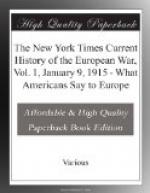EDWARD PICK.
New York, Oct. 27, 1914.
[Illustration]
Defense of the Dual Alliance—A Reply
By Dr. Edmund von Mach.
Instructor of Fine Arts, Harvard, 1899-1903; Instructor in History of Art, Wellesley College, 1899-1902; Lecturer in History of Art, Bradford Academy, Cambridge, Mass. Author of many books on Greek and Roman sculpture and the history of painting. Served in the German Army, 1889-91.
Hon. James M. Beck has eloquently argued the case of the Allies against Germany and Austria-Hungary, and submitted his findings with confident assurance of their acceptance by the Supreme Court of Civilization. Carried away by his zeal he has at times used terms not warranted by the evidence, such as “the irrepressible Kaiser,” “stupid falsehood,” “duplicity,” and the like, but since the court can be trusted to disregard such expressions no further attention will be paid to them.
To a certain extent this article is not a reply but a continuation of Mr. Beck’s argument, for, wherever our personal sympathies may lie, we are all equally interested in discovering the truth. In the final settlement of peace American public opinion may, nay, will, have a prominent voice. If it is exerted on the strength of a true understanding of European events, it will contribute to the establishment of a lasting peace.
As to the evidence submitted Mr. Beck seems to err in believing that Governments are accustomed to publish in their various white, gray, or orange papers “the truth, the whole truth, and nothing but the truth.” This is nowhere done, for there are many bits of information which come to a Government through its diplomatic connections which it would be indelicate, discourteous, or unwise to give to the public. The official documents on American foreign relations and all white, gray, or orange papers are “edited.” They are understood to be so by Congress, Parliament, the Reichstag, the Duma, &c., and no charge of dishonesty can be maintained against the respective Governments on that score.
If the Chancellor says that Germany was using her good offices in Vienna, this is as valuable a bit of evidence as the reprint of a dispatch in the “White Paper,” unless we wish to impugn his veracity, and in that case the copy of a dispatch would be valueless, for he might have forged it. The entire argument, therefore, against Germany and Austria, based on what Mr. Beck calls the “suppression of vitally important documents,” is void, unless you will apply it equally to Great Britain and the other countries.
In Sir Edward Grey’s “White Paper” Mr. Beck has missed no important documents because he looked at England’s well-prepared case through sympathetic eyes, and it did not occur to him to ask, “Where are all the documents bearing on Italian neutrality?” Does he believe that England was so little interested in the question whether she would have to fight two or three foes, and whether her way to Egypt and India would be safe or threatened? There are many dispatches to and from Rome included in the “White Paper,” but not a mention of Italy’s position.




